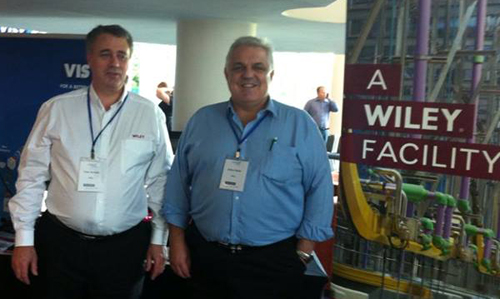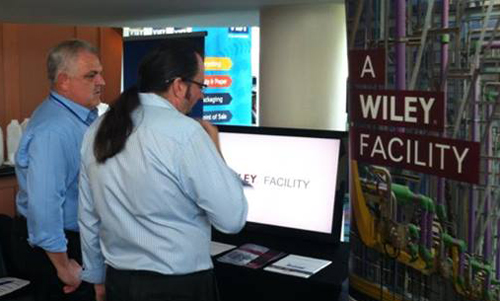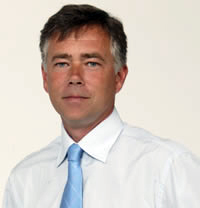In July of this year the annual Dairy Industry Association of Australia (DIAA) Queensland Division Conference took place at the RACV Royal Pines Resort on the Gold Coast. Naturally, Wiley sent along their Dairy Industry Specialist, Arthur Seiler, and Business Development Manager, Peter Bullock.

Wiley’s Peter Bullock and Arthur Seiler
The DIAA is a not-for-profit organisation that promotes and supports the Australian dairy industry and all its associated stakeholders. As a result, the conference played host to a broad cross-section of delegates from the Queensland sector of the industry; from small owner operators, like boutique cheesemakers Maleny Cheese, to large multi-national operators like Parmalat. Other representatives that attended included delegates from support industries and regulatory bodies.

Arthur confers with industry peer Rick Werner, Engineering Manager for Norco
The conference provides a rare opportunity for those involved in the dairy industry to catch up on the current issues and innovations impacting the industry. A range of guest speakers presented on a number of topics including: marketing strategies for milk and yoghurt, lean manufacturing, and Australian co-operatives working with the major retailers to support the dairy industry. However, two presentations stood out among the rest.
Darren Irwin from SPX Service Solutions showcased a case study of a new dairy factory under construction in the UK that heralded promising innovations for the industry. The striking statistic that he boasted was a remarkably low water-to-milk ratio, which he stated as being 0.29L of water for every litre of milk processed. Benchmark improvements in dairy production design continue to illustrate the importance placed on economic design as a result of ecological considerations. It’s these considerations that are one of the main driving forces for innovation in the food processing industry as a whole.

Additionally, Darren outlined the implementation of a new pasteurisation method for fresh milk that exposes product to higher temperature for a shorter period of time. Studies have shown that this process results in improvements in shelf life and milk flavour; they suggest that low fat milk inherits the characteristic taste of normal reduced fat milk, reduced fat the flavour of full fat, and full fat beyond the current standard of pasteurised full fat milk. This remarkable progression in milk processing will ease the dietary consciences of many milk connoisseurs.

Jonathan Pain, global economist
While not strictly a dairy industry professional, global economist Jonathan Pain also brought some original thinking to the conference floor. Jonathan’s global approach yielded fascinating revelations for the directions and markets the dairy industry can and should be looking to. The point of contention that was of most significance was that the apparent Global Financial Crisis was only global insofar as it affected the Western world, while economies in other geopolitical climes observed little downturn. Despite some media reports, China is continuing to grow and, as such, Australia should start looking toward the potential for Asian imports as an area of expansion for the dairy industry. With a presence in Asia already Wiley are certainly heading towards taking advantage of this growth potential.

The DIAA Conference also provided an opportunity for the presentation of a compelling innovation in milk packaging methods. Robert Dvorak of Visy Plastics showcased the increasing potential for completely sustainable milk bottles. He unveiled that Visy now has the capability to recycle used bottles to create empty food grade HDPE bottles that meet packaging standards.
Visy have constructed a new Australian factory that utilises similar processes to those that have already been established in the UK and across other regions of Europe. While the current process is one that promises a variable percentage of recycled material in new packaging, there is room for further improvement. Visy also hinted at the potential for further growth in this sector of processing across the Australian markets.
The DIAA Queensland Division Conference presented an incomparable opportunity for dairy industry representatives to network and touch base with the wider machinations of the industry at large. Wiley’s presence at such conventions supplies us with up-to-date market and industry knowledge to keep us on the forefront of the coal face which enables us to deliver the best advice and food processing engineering we possibly can.


